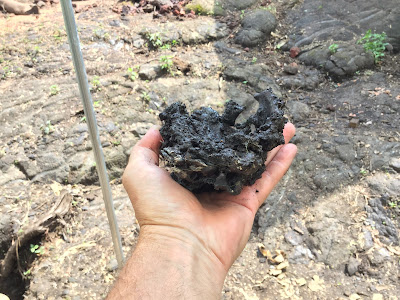The first round of iron melting in the Sumihira style Oroshigane furnace went so well, I just had to keep going. I used my last bit of bundle wrap wire during the first melt, but I still wanted to see how this furnace would handle a slightly larger mass of metal.
How about a remelt of last year's pseudo-successful “Aristotle” run? If you look closely, you can see the remains of the partially melted feedstock still stuck to the mass of the bloom.
The original melt of this blob of metal took over two hours and resulted in no notable increase in the carbon content. The mild steel rebar bundle wrap that originally tested as low carbon came out looking very different, but the spark looked much the same (perhaps it was just surface decarburization; I should've cut and polished the interior, but didn't). The reason that the melt took so long was because during the burn, the area around the tuyere (air inlet) had quickly melted and was continually dripping down to block the airflow. Not enough air = not enough heat. It did make a nice, very dense bloom however.
Since the new furnace was already good and hot, I plopped the old bloom in at the bottom, then filled it with charcoal right to the top of the shaft. It only took a short while before the charcoal was fully burning with a sparse red flame.
The flame becomes more “solid” as the metal begins to melt.
The previous burn produced a bloom that looked burnt to me and had a significant amount of cast iron in the composition. This time, as the flame begins to shift slightly into the yellow flame stage, I briefly turn off the blower (the hateful air mattress inflator!) and give a listen to the fire. I definitely hear the iron “boiling”, so I turn the blower back on and refill the shaft with charcoal one last time.
As soon as the charcoal level drops to the level of the tuyere…….
…..it's time to check out the results. This time the melt took, at most, 15 minutes.
The thin gray mass on the left that is stuck to the bloom is the sacrificial charcoal/clay inner lining of the furnace, doing what it is supposed to; prevent the molten iron from sticking directly to the furnace itself.
And, the result.
Another cup shaped bloom. The air blast was travelling from the ball of my thumb towards the tip of my pinky finger, as it were. There is a small bit of furnace lining stuck to the bloom (on the left) where it had briefly adhered to the wall underneath the tuyere.
I like the appearance of this bloom better than the last, in any event. It looks like the force of the air blast was scouring the top of the bloom and throwing the small amount of slag against the wall. Because this isn't a smelting furnace for reducing iron from ore, the slag is most likely from the slight amount of wall erosion around the tuyere.
The underside of the bloom has many globular masses that sparked as high carbon steel.
Looking into the furnace, you can see that the tuyere has eroded to be nearly flush with the wall of the shaft and there is evidence of spalling, as the walls vitrify and fracture off. You can also see the unstuck half of the sacrificial carbon/clay plate that the bloom sat upon.
The first two blooms from this furnace have been cup shaped in profile. I'm sure that someone with experience in these matters could tell in a moment what this says about the internal environment of the furnace is exactly, but I will need to do more experimenting. I suspect that that I've got the air blast set too high, but we will see.
Soon.










Yesssss! Good gracious you have been having too much fun, ha. I...want to....hammer on that last bloom. The power blower in Franks shop that Taylor has been using for demos is incredibly quiet, I can hear the air moving in the coal bed quite nicely, but anthracite doesn't react to the heating iron like charcoal at all. The hand crank blowers rattle in a disquieting manner, though it may be because they're all antiques in need of precision balancing.
ReplyDeleteI had the funnest time pulling black sand out of the soil using a magnet with Lilly before I left for NM, it really sparked her curiosity (and mine as well).
Now you just need to coax that volcano near you into coughing up a couple of golf ball sized diamonds...I suppose they're just shiny rocks for yahoo's when you finally crack the jewel steel nut.
“Now you just need to coax that volcano near you into coughing up a couple of golf ball sized diamonds…”
DeleteMight be prophetic words Gabe!
Kilauea’s main lava column has been dropping at a furious pace and is projected to be so low as to reach the regional water table, maybe today! This means gigantic amounts of water will be instatly converted to steam vapor, knocking loose all sorts of rock which then plugs the chimney. Pressure builds…….BOOM! Again and again, haha! We aren't talking about Mt. Saint Helens here, but there might be ejecta that goes for a few miles or so. Lava bombs! This is up at the main crater BTW, not the lower vent that is currently wreaking havoc on lower Puna, although the interaction of the two related systems might turn into something even crazier…..
Fun times on the Big Island (Famous last words???), Haha!